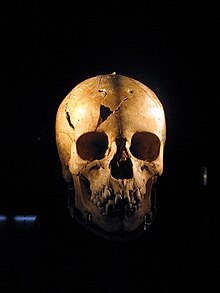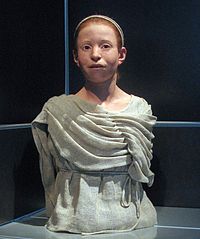Myrtis
Myrtis | |
|---|---|
 Myrtis' skull | |
| Born | 441 BC |
| Died | 430 BC (agedc.11) |
| Body discovered | 1994–95 |

Myrtisis the name given by archaeologists to an 11-year-old girl fromancient Athens,whose remains were discovered in 1994–95 in amass graveduring work to build the metro station atKerameikos,Greece.[1]The name was chosen from common ancient Greek names.[2]The analysis showed that Myrtis and two other bodies in the mass grave had died oftyphoid feverduring thePlague of Athensin 430 BC.[1]
TheUnited Nations Regional Information Centremade Myrtis a friend of theMillennium Development Goalsand used her in the UN campaign "We Can End Poverty".[3]
Reconstruction[edit]
Human skeletal evidence fromClassical Greeceis scarce, as most burials at that time were preceded bycremation.Before Myrtis, no attempt to reconstruct an Ancient Greek layperson's face has been recorded.[2]
Myrtis' skull was in an unusually good condition and Greekorthodonticsprofessor Manolis Papagrigorakis requested help from Swedish specialists to recreate her facial features. A special scanner was employed for the non-invasive acquisition of high-resolution anatomic data of Myrtis' skull. The volume of the skull was determined at 446 cm3.Following scanning, an exact replica of her skull was created, which became the basis for subsequentforensic facial reconstruction.The reconstruction process followed the so-called "Manchester method": the facial tissues were laid from the skull surface outward by using depth marker pegs to determine thickness. The shape, size and position of the eyes, ears, nose and mouth were determined through the features of the underlying skeletal tissues. 20 different muscles were sculpted. The thickness of the facial tissues were evaluated according to average values taken from corresponding reference tables for age, gender and race.[2]The mouth width and the lip thickness were estimated by the pattern and the skeletalcraniofacialattributes of the associated area.[2]Myrtis' reconstructed face was given brown eyes and red hair.[1]The hairstyle she was given follows the fashion of the time.
Dental condition[edit]
A class II skeletal anddental malocclusionwas observed in Myrtis' remains.[4]Other reported dental issues are theectopiclabial eruption of themaxillarycaninesmesially to their retained deciduous predecessors, the ectopic distally directed eruption of a lower firstpremolarand a unilaterally missing lower thirdmolar.[4]
See also[edit]
Notes[edit]
- ^abc"'Myrtis' exhibition at National Archaeological Museum ".ANA-MPA. 8 April 2011.Retrieved8 April2011.
- ^abcdManolis J. Papagrigorakis; Philippos N. Synodinos; Aristomenis Antoniadis; Emmanuel Maravelakis; Panagiotis Toulas; Oscar Nilsson; Effie Baziotopoulou-Valavani (2011)."Facial reconstruction of an 11-year-old female resident of 430 BC Athens".The Angle Orthodontist.81(1). Angle: 169–177.doi:10.2319/012710-58.1.PMC8926360.PMID20936971.
- ^"Myrtis has been named" friend of the United Nations ""(in Greek). GR: Myrtis.Retrieved8 April2011.
- ^abBaziotopoulou-Valavani, Effie; Synodinos, Philippos N.; Papagrigorakis, Manolis J. (January 2008)."Dental status and orthodontic treatment needs of an 11-year-old female resident of Athens, 430 BC".Angle Orthod.78(1): 152–6.doi:10.2319/012107-30.1.PMID18193954.
External links[edit]
![]() Media related toMyrtis reconstruction in the National Archaeological Museum of Athensat Wikimedia Commons
Media related toMyrtis reconstruction in the National Archaeological Museum of Athensat Wikimedia Commons

